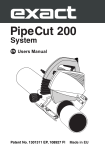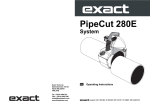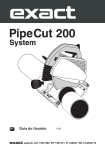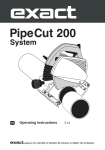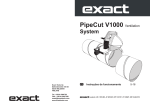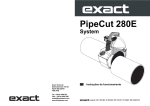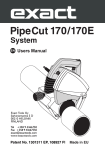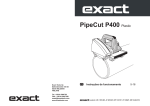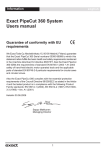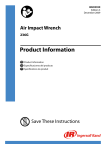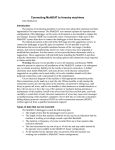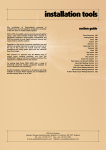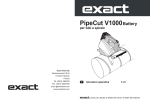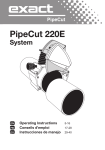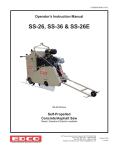Download Exact200Manual
Transcript
EN Operating Instructions 5-16 patents: US 7,257,895, JP 4010941, EP 1301311, FI 108927, KR 10-0634113 Exact PipeCut 200 System Blade information for Exact PipeCut saws TCT (tungsten carbide tip) saw blades are for cutting steel, copper, aluminium and all kind of plastics. TCT blades can be sharpened. Cermet (ceramic alloy tip) saw blades are for cutting stainless steel, acid proof materials, steel, copper, aluminium and all kind of plastics. Cermet blades can be sharpened. Diamond blades are for cutting cast iron only. Diamond blades can not be sharpened. 2 A 1. 2. 3. 4. 5. 6. 7. 8. 9. 10. 11. 12. 13. 14. 15. 16. 17. 3 Declaration of Conformity We declare under our sole responsibility that the products described under “Technical Data” are in conformity with the following standards or standardization documents: EN60745 according to the provisions of the directives 2004/108/EC, 2006/42/EC. For more information, please contact Exact Tools at the following address. The technical file is available at the address underneath. Helsinki, 1.1.2010 Seppo Makkonen, Managing director Exact Tools Oy Särkiniementie 5 D FI-00210 Helsinki Finland 4 Contents english Contents 6. Technical data 6. Package contents Safety 7. Safety instructions Operation 10. 10. 11. 11. 11. 11. 12. 12. 12. 13. 13. Functional description Product features Before operating the tool Connection to the mains power supply Precise setting of the cutting point Setting the pipe on supports Attaching the pipe saw to the pipe Piercing the pipe wall Sawing around a pipe Overload protection Straightness of cut and adjusting wheel 14. Installing and changing the saw blade 14. Service and maintenance instructions 16. Environment /Disposal 16. Guarantee/Guarantee conditions 16. Tips for users Exploded view (separate attachment) Definitions: Safety guidelines The definitions below describe the level of severity for each signal word. Please read the manual and pay attention to these symbols. DANGER: Indicates an imminently hazardous situation which, if not avoided, will result in death or serious injury. WARNING: Indicates a potentially hazardous situation which, if not avoided, could result in death or serious injury. CAUTION: Indicates a potentially hazardous situation which, if not avoided, may result in minor or moderate injury. NOTICE: Indicates a practice not related to personal injury which, if not avoided, may result in property damage. Denotes risk of electric shock. 5 Information Kuva A english Operating, safety, and servicing instructions Please read this operating, safety, and servicing instructions carefully before using the pipe saw. Also store this instruction book somewhere accessible to everyone using the pipe saw. In addition to these instructions, always follow the official work, health and safety regulations. The Exact PipeCut is meant for professional use only. Technical data Model Voltage 1 Voltage 2 Power No-Load speed Intermittent operation Blade diameter Mounting bore Weight Range of use Ø Max. pipe wall steel Max. pipe wall plastics Protection class Spindle lock Speed preselection Constant electronic control Overload Protection Reduced starting current LpA (sound pressure) KpA (sound pressure uncertanity) LWA (acoustic power) KWA (acoustic power uncertanity) Pipecut 200 220 - 240 V / 50-60 Hz 100 - 120 V / 50-60 Hz 1100 W 4300 /min 2,5 min ON / 7,5 min OFF (S3 25%) 140 mm (5.51”) 62 mm (2,44”) 8,9 kg (20 lbs) 15 mm –200 mm (0,6”- 6”) 8 mm(0,31” ) 12 mm (0,45”) / II yes no no yes no 93,5 dB(A) 3 dB(A) 108,5 dB(A) 3 dB(A) The values given are valid for nominal voltages [U] of 230/240V. For lower voltage and models for specific countries, these values can vary. Please observe the article number on the type plate of your machine. The trade names of the individual machines may vary. Only for power tools without reduced starting current: Starting cycles generate brief voltage drops. Interference with other equipment/machines may occur in case of unfavourable mains system conditions. Malfunctions are not to be expected for system impedances below 0.36 ohm. 6 Information Kuva A english Noise/Vibration Information Measured values determined according to EN60745. Wear hearing protection! Vibration total values (triax vector sum) determined according to EN60745: Vibration emission value ah =0,35 m/s2, UncertaintyK =1.5 m/s2. The vibration emission level given in this information sheet has been measured in accordance with a standardised test given in EN 60745 and may be used to compare one tool with another. It may be used for a preliminary assessment of exposure. WARNING:The declared vibration emission level represents the main applications of the tool. However if the tool is used for different applications, with different accessories or poorly maintained, the vibration emission may differ. This may significantly increase the exposure level over the total working period. An estimation of the level of exposure to vibration should also take into account the times when the tool is switched off or when it is running but not actually doing the job. This may significantly reduce the exposure level over the total working period. Identify additional safety measures to protect the operator from the effects of vibration such as: maintain the tool and the accessories, keep the hands warm, organisation of work patterns. Exact PipeCut 200 pipecutting system, Package contents: Please check the package contains the following items : 1. Pipecutting System case 2. Exact PipeCut 200 pipe saw 3. Cutting supports 4x 4. Operating instructions 5. Hex socket key 5 mm and 2 mm fitted to the machine 6. TCT blade 140 x 62 fitted on the machine 7. DVD-video disc with instructions 4. 1. 3. 5. 6. 2. 7. 7 Safety english General power tool safety warnings or under the influence of drugs, alcohol or medication. A moment of inattention while operating power tools may result in serious personal injury. b) Use personal protective equipment. Always wear eye protection. Protective equipment such as dust mask, non-skid safety shoes, hard hat, or hearing protection used for appropriate conditions will reduce personal injuries. WARNING: Read all safety warnings and all instructions. Failure to follow the warnings and instructions may result in electric shock, fire and/or serious injury Save all warnings and instructions for future reference. c) Prevent unintentional starting. Ensure the switch is in the off-position before connecting to power source, picking up or carrying the tool. Carrying power tools with your finger on the switch or energising power tools that have the switch on invites accidents. d) Remove any adjusting key or wrench before turning the power tool on. A wrench or a key left attached to a rotating part of the power tool may result in personal injury. e) Do not overreach. Keep proper footing and balance at all times. This enables better control of the power tool in unexpected situations. f) Dress properly. Do not wear loose clothing or jewellery. Keep your hair, clothing and gloves away from moving parts. Loose clothes, jewellery or long hair can be caught in moving parts. g) If devices are provided for the connection of dust extraction and collection facilities, ensure these are connected and properly used. Use of dust collection can reduce dust-related hazards. h) Do not overreach. Keep proper footing and balance at all times. This enables better control of the power tool in unexpected situations. i) Dress properly. Do not wear loose clothing or jewellery. Keep your hair, clothing and gloves away from moving parts. Loose clothes, jewellery or long hair can be caught in moving parts. j) If devices are provided for the connection of dust extraction and collection facilities, ensure these are connected and properly used. Use of dust collection can reduce dust-related hazards. The term “power tool” in the warnings refers to your mains-operated (corded) power tool or batteryoperated (cordless) power tool. 1. Work area safety a) Keep work area clean and well lit. Cluttered or dark areas invite accidents. b) Do not operate power tools in explosive atmospheres, such as in the presence of flammable liquids, gases or dust. Power tools create sparks which may ignite the dust or fumes. c) Keep children and bystanders away while operating a power tool. Distractions can cause you to lose control. 2. Electrical safety a) Power tool plugs must match the outlet. Never modify the plug in any way. Do not use any adapter plugs with earthed (grounded) power tools. Unmodified plugs and matching outlets will reduce risk of electric shock. b) Avoid body contact with earthed or grounded surfaces, such as pipes, radiators, ranges and refrigerators. There is an increased risk of electric shock if your body is earthed or grounded. c) Do not expose power tools to rain or wet conditions. Water entering a power tool will increase the risk of electric shock. d) Do not abuse the cord. Never use the cord for carrying, pulling or unplugging the power tool. Keep cord away from heat, oil, sharp edges and moving parts. Damaged or entangled cords increase the risk of electric shock. e) When operating a power tool outdoors, use an extension cord suitable for outdoor use. Use of a cord suitable for outdoor use reduces the risk of electric shock. f) If operating a power tool in a damp location is unavoidable, use a residual current device (RCD) protected supply. Use of an RCD reduces the risk of electric shock. 4. Power tool use and care a) Do not force the power tool. Use the correct power tool for your application. The correct power tool will do the job better and safer at the rate for which it was designed. b) Do not use the power tool if the switch does not turn it on and off. Any power tool that cannot be controlled with the switch is dangerous and must be repaired. c) Disconnect the plug from the power source from the power tool before making any adjustments, changing accessories, or storing power tools. Such preventive safety measures reduce the risk of starting the power tool accidentally. 3. Personal safety a) Stay alert, watch what you are doing and use common sense when operating a power tool. Do not use a power tool while you are tired 8 Safety english d) Store idle power tools out of the reach of children and do not allow persons unfamiliar operate the power tool. Power tools are dangerous in the hands of untrained users. e) Maintain power tools. Check for misalignment or binding of moving parts, breakage of parts and any other condition that may affect the power tool’s operation. If damaged, have the power tool repaired before use. Many accidents are caused by poorly maintained power tools. f) Keep cutting tools sharp and clean. Properly maintained cutting tools with sharp cutting edges are less likely to bind and are easier to control. g) Use the power tool, accessories and tool bits etc. in accordance with these instructions, taking into account the working conditions and the work to be performed. Use of the power tool for operations different from those intended could result in a hazardous situation. g) When blade is binding, or when interrupting a cut for any reason, release the trigger and hold the saw motionless in the material until the blade comes to a complete stop. Never attempt to remove the saw from the work or pull the saw backward while the blade is in motion. Investigate and take corrective actions to eliminate the cause of blade binding. h) When restarting a saw in the workpiece, centre the saw blade in the kerf and check that saw teeth are not engaged into the material. If saw blade is binding, it may walk up from the workpiece as the saw is restarted. i) Support tubes to minimise the risk of blade pinching. Tubes tend to sag under their own weight. Supports must be placed under the saw on both sides, near the line of cut and near the edge of the panel. j) Do not use dull or damaged blades. Unsharpened or improperly set blades produce narrow kerf causing excessive friction and blade binding. k) Use extra caution when making a “plunge cut” into existing walls or other blind areas. The protruding blade may cut objects that can cause kickback. l) Check lower guard for proper closing before each use. Do not operate the saw if lower guard does not move freely and close instantly. Never clamp or tie the lower guard into the open position. If saw is accidentally dropped, lower guard may be bent. Raise the lower guard with the retracting handle and make sure it moves freely and does not touch the blade or any other part, in all angles and depths of cut. m) Check the operation of the lower guard. If the guard and the spring are not operating properly, they must be serviced before use. Lower guard may operate sluggishly due to damaged parts, gummy deposits, or a build-up of debris. n) Do not reach into the saw dust ejector with your hands. They could be injured by rotating parts. o) Do not work overhead with the saw. In this manner you do not have sufficient control over the power tool. p) Do not operate the power tool stationary. It is not designed for operation with a saw table. q) Do not use high speed steel (HSS) saw blades. Such saw blades can easily break. r) When working with the machine, always hold it firmly with both hands and provide for a secure stance. The power tool is guided more secure with both hands. 5. Service a) Have your power tool serviced by a qualified repair person using only identical replacement parts. This will ensure that the safety of the power tool is maintained. Safety warnings for circular saws a) b) c) d) e) f) DANGER: Keep hands away from cutting area and the blade. Keep your second hand on motor housing. If both hands are holding the saw, they cannot be cut by the blade. Do not reach underneath the workpiece. The guard cannot protect you from the blade below the workpiece. Never hold the workpiece being cut in your hands or across your leg. Secure the workpiece to a stable platform. It is important to support the work properly to minimize body exposure, blade binding, or loss of control. Hold the power tool only by the insulated gripping surfaces when performing an operation where the cutting tool may contact hidden wiring or its own cord. Contact with a “live” wire will also make exposed metal parts of the power tool “live” and shock the operator. Always use blades with correct size and shape (diamond versus round) of arbour holes. Blades that do not match the mounting hardware of the saw will run eccentrically, causing loss of control. Never use damaged or incorrect blade washers or bolt. The blade washers and bolt were specially designed for your saw, for optimum performance and safety of operation. 9 Safety s) Secure the workpiece. A workpiece supported by pipe holders is held more secure than by hand. t) Always wait until the machine has come to a complete stop before placing it down. The tool insert can jam and lead to loss of control over the power tool. u) Never use the machine with a damaged cable. Do not touch the damaged cable and pull the mains plug when the cable is damaged while working. Damaged cables increase the risk of an electric shock. Additional specific safety rules The pipe saw must never be used in the following cases, if: • There is water or another liquid, explosive gases or poisonous chemicals inside the pipe to be cut. • The power switch is faulty. • The power cable is faulty, • The blade is bent. • The blade is blunt or in poor condition. • The plastic components are cracked or have parts missing. • The gripper unit is not properly tightened around the pipe or if it is warped. • The blade guard cover or moving blade guard has been damaged or removed from the machine. • The locking mechanisms do not work properly (UNLOCK-button). • The pipe saw has become wet. When using the pipe saw, the following factors must always be taken into consideration: • Support tubes to minimise the risk of blade pinching. • Ensure that the pipe to be cut is empty. • Ensure that the blade is correctly installed. • Ensure that the diameter and thickness of the blade are suitable for the pipe saw and that the blade is suitable for the rpm-range of the machine. • Never use sideways force to stop the blade, always allow the blade to stop freely. • Check the attachments of the blade guards. • Never use excessive force when using the pipe saw. • Never use the pipe saw to lift the pipe while it is still attached to the pipe. • Avoid overloading the electric motor. • Always follow the safety and operating instructions and current regulations. english Functional Description Read all safety warnings and all instructions. Failure to follow the warnings and instructions may result in electric shock, fire and/or serious injury. Intended Use PipeCut 200: The PipeCut 200 pipe saw is intended for use as a pipe fitter’s tool at the installation site. The PipeCut 200 pipe saw can only be used to cut round pipes, with a diameter of 15-200 mm (0,6”-8”) and a maximum wall thickness of 8 mm with steel and other ferrous and non-ferrous materials and 14 mm with plastics. The PipeCut 200 pipe saw can be used to cut all normal pipe materials, such as steel, stainless steel, cast iron, copper, aluminium and plastic. PipeCut 200 pipe saw is intended for short, intermittent use. The machine may be loaded for 2,5 minutes during a 10-minute period (S3 25 %). PipeCut 200 pipe saw is not intended for use in industrial production. Use pipe holders to support pipe. Product Features While reading the operating instructions, unfold the graphics page for the machine and leave it open. This page is folded under the cover of this manual (page 3). The following numbering of the product features refers to this illustration. Figure A 1. UNLOCK button 2. Power switch 3. Power-switch locking lever 4. Blade-guard cover 5. Blade-guard finger screw 6. Moving blade-guard 7. Edge of moving blade-guard 8. Braking wheels 9. Adjusting wheel 10.Operating handle 11.Spindle-lock button 12.Blade-guard finger screw 13.Motor unit 14.Rating plate 15.Overload protection 16.Gripper unit 17.Gripper adjustment handle 10 Operation Exact PipeCut 200 pipecutting system operating instructions Fig C Before operating the tool Ensure that the motor unit is in the upright position. The yellow mark of the UNLOCK button is visible. Cutting mark Cutting point 20mm Check that the blade is correctly fitted, in good condition and suitable for the material to be cut. Precise setting of the cutting point When you mark the cutting point on the pipe to be cut, deduct 20 mm from the required dimension (Easy-to-remember rule: The cutting mark location requires a measurement of - 20 mm.)(Figure C) Ensure the pipe saw guide wheels rotate. Ensure the support wheels rotate. Check the operation of the lower blade guard. Ensure the pipe is empty. Setting the pipe on supports Use the system supports when cutting pipes. This will ensure safe working and optimum result. Work on flat underground. Place the pipe on two supports so that the cutting point is between the supports. Place two more support under both ends of the pipe. Check that all support wheel contact the pipe (adjust if required e.g. with pieces of lumber) (figure B). When cutting short pipes (25cm or less) place the supports so that the cutting point is outside supports (figure D). Support the pipe with your left leg, if required. Proper arrangements will prevent the blade from jamming as the pipe is cut through. It plastic pipes have been cut with the pipe saw (resulting in long, statically charger slivers), open the blade guard cover, and clean carefully the lower blade guard and the entire pipe saw. Connection to the mains power supply Ensure that the mains voltage is the same as indicated on the rating plate (Figure A/14). Connect the pipe saw to the power outlet only after having checked this. Fig B Fig D 11 Operation Fig E Attaching the pipe saw to the pipe Open the pipe saw's gripper unit enough to suit the diameter of the pipe by rotating the adjustment handle located at the rear of the saw (Fig. E/1). Position the pipe saw on top of the pipe so that the edge of the lower blade guard is at the cutting mark. Fasten the pipe saw to the pipe by turning the gripper adjustment handle until the gripper grips firmly the pipe to be cut (Figure E/2). Hold the pipe in place and ensure that pipe saw moves freely in the direction the pipe is fed. For sake of safety ensure the pipe saw leads are to the left of the pipe saw. The pipe saw is now ready for cutting. 2 1 Fig F Piercing the pipe wall 2 Grip the gripper firmly with your right hand and place your left foot on top of the pipe approximately 50cm from the pipe saw. Turn the saw until it leans slightly forward (Figure H). When starting the motor, first of all release the power-switch locking lever (Fig F/1) and push the power switch all the way down (Fig F/2). Before starting to saw, wait until the blade reaches full speed. Pierce the pipe wall by pressing pipe saw operating handle downwards slowly and evenly until the blade has cut through the pipe wall (at this stage the pipe must not rotate) and the motor unit is locked in the sawing position (Fig H/1).. Look at the UNLOCK button during the piercing operation. When UNLOCK button is locked, i.e. the yellow mark disappears (Fig G), pipe saw is locked in the sawing position, and you can safely start sawing around the pipe. 1 Fig G 2 Fig H Sawing around the pipe 1 3 Start sawing by feeding the pipe saw forward and fix the pipe with your left foot (Fig H/3).. After that release the pipe (remove your left foot from the pipe) and turn the pipe saw backwards, whereby the pipe will also be rotated backwards (Fig J). Start a new feeding movement, and feed continuously forward ca. 1/6 of the pipe's circumference. Repeat until the pipe is cut off (Fig K). 12 Operation Fig J Select the sawing speed as per the material and the thickness of the wall. Too high speed can damage the blade, overload the pipe saw and give a poor sawing result. When the pipe is cut off, push the UNLOCK button forward until the yellow mark is visible and the locking is released (Fig L/1). Now raise the motor unit to starting position (Fig L/2). Release the power switch (Fig L/3). When the blade is stationary, remove the pipe saw from the pipe by loosening the gripped handle (Fig L/4). Ensure that the moving lower bladeguard is lowered into safety position. 1/6 Fig K Should there be problems during piercing or sawing, abnormal sounds or vibrations due to which you have to interrupt sawing before the pipe is cut through, release the blade by pushing the UNLOCK button forward until the UNLOCK button is released, and lift the motor unit up. Once the problem is cleared, start sawing again. Never start the motor, when the motor unit is locked in sawing position or teeth of the blade contact the pipe to be sawn. 1 Overload protection Fig L 3 The pipe saw is equipped with overload protection. When the blade is dull or the speed is too high, the overload protection cuts power automatically. Restore the power by pushing the overload protection switch (Fig A/15). 2 Straightness of cut and adjusting wheel 4 The cut is affected by many factors, e.g. the size of the pipe, the material, the wall thickness, the quality of the pipe's surface, the roundness, welded seams, blade condition, feed rate, operator's experience. For this reason the result may vary, and the cut may turn to left or right (misalignment of the cut's starting and ending point) (Fig M). The pipe saw gripper has one adjustable wheel (Fig A/9) which be used for improving the quality of the cut and for reducing the misalignment. Fig M The adjustment applies only to the actual pipe size and material, and the wheel may have to be readjusted as the blade is worn. Step to left 13 Step to right Operation, maintenance The wheel can be adjusted in 9 positions; mid position and 4 steps to left and right. To adjust the wheel, loosen the locking screw (Fig N/1) and turn the wheel center clockwise or counterclockwise to the desired position (Fig N/2), and lock the wheel again (Fig N/3). If the blade has wandered too much to the right, adjust wheel center clockwise. It the misalignment is to the left, adjust counterclockwise. The number of steps depend on the actual misalignment. Remember to lubricate the adjusting wheel at regular intervals. 1 Fig N 3 2 Installing and changing the saw blade Remove the power plug from the socket. Check that the motor unit is locked in the upper position. Fig O 2 7 6 5 Remove the blade guard cover (Fig. O/1) by opening the two finger screws (Fig. O/2). Press the spindlelock button (Fig. A/11) and simultaneously rotate the blade by hand until the spindle-lock button drops a further distance of about 7 mm. Now the rotation of the blade is prevented. Use the blade key to open the blade attachment bolt. Remove the securing bolt (Fig. O/3), the washer (Fig. O/4), the blade flange disc (Fig. O/5), and the blade (Fig. O/6). Before installing a new blade, check that both blade flange discs are clean. Place a new or sharpened blade on the back flange disc (Fig. O/7), so that the marked side of the blade is facing outwards and the arrows on the blade are facing in the same direction as the rotation direction markings on the inside of the blade case. Ensure that the new blade goes right to the bottom in the back flange disc. Put the blade flange disc, the washer, and the securing bolt back in place. Press the spindle lock button and tighten the blade securing bolt. Put the blade guard cover back in place and tighten the finger bolts. 4 3 1 1 Fig P 3 4 Maintenance and servicing instructions 2 Remove the power plug from the socket before servicing or cleaning the pipe saw. All maintenance operations carried out on the pipe saw’s electrical components must be carried out at an approved service agency. 14 Environment, guarantee Environment Blade Check the condition of the blade. Replace a bent, blunt, or otherwise damaged blade with a new one. Using a blunt blade can overload the pipe saw’s electric motor. When you notice that the blade is blunt, do not continue sawing with it, as the blade may become so badly damaged that it will not be worth sharpening. A blade in sufficiently good condition can be sharpened a few times by a professional sharpening company. Exact-blades. Separate collection. This product must not be disposed of with normal household waste. When your Exact PipeCut 200 machine is worn out, do not dispose of it with normal household waste. This product must be recycled separately. Separate recycling of used products and packaging facilitate recycling and recovery of materials. Reusing of recycled materials helps prevent pollution of environment. According to local regulations it is possible to deliver household appliances to municipal rubbish depositories or to the dealer when buying a new product. Gripper unit Clean the gripper unit regularly with compressed air. Lubricate the gripper’s wheel axles (Fig. P/1) and its joints (Fig. P/2). Also clean and lubricate the gripper’s trapezoidal screw (Fig. P/3) and the two worm screws on it (Fig. P/4). Guarantee Blade guard When you have sawn plastic pipes and then intend to start sawing metal pipes always clean the inside of the blade guards. Hot particles derived from sawing metal will burn plastic particles, which may release toxic smoke. Make it a rule to clean the blade guard regularly, and pay special attention to keep the moving blade guard movement from becoming hampered. Lubricate the axis of the moving blade guard regularly. If the Exact PipeCut 200 pipe saw becomes unusable due to material or manufacturing faults within 24 months of the date of purchase, we will replace the damaged parts with new ones or supply an entirely new or factory-reconditioned pipe saw to replace the damaged one. The guarantee is only valid if: The guarantee card or a dated purchase receipt is returned to the manufacturer or retailer. The pipe saw has not been misused. No attempt has been made by non-approved persons to repair the saw. The pipe saw has been used in accordance with these operating, safety, and servicing instructions. The guarantee does not apply to blades or the overload protection. Motor Keep the motors cooling vents clean. Plastic parts Clean the plastic parts with a soft rag. Only use mild detergents. Do not use solvents or other strong detergents as they may damage the plastic parts and paint surfaces. Power cable Check the condition of the power cable regularly. A faulty power cable should always be replaced at an approved service agency. Due to continuous product development, the information in this instruction book may change. We do not give separate notification of changes. Correct use and regular servicing and cleaning will ensure the continued operation of the pipe saw. 15 Tips english Tips for using Exact PipeCut saws Factors that affect the lifetime of the saw blade: • material of the pipe • correct blade type for material being cut • correct motor speed setting (model 170E) • wall thickness of the pipe • feeding speed • smoothness of the pipe • user’s general skills • cleanness of the pipe • rust on the pipe • welded seam in the pipe • blade speed Diamond blade should only be used for cutting cast iron pipe. It is not recommended to cut cast iron with TCT or Cermet blades. Clean the inside of the blade guards after cutting plastic pipe. Smaller pipe is easily cut by rotating the pipe by hand either on a table or on the floor. Please note: rotate pipe towards you when rotating by hand and be careful not to rotate too fast. Factors that affect the straightness of the cut: Check the condition of the blade regularly. • condition of the saw blade • wall thickness of the pipe • feeding speed • smoothness of the feed • user’s general skills • cleanness of the pipe • roundness of the pipe • gripper unit too loose or too tight • blade assembled too tight The cutting procedure is divided into two stages; first saw through the pipe wall, then complete the cut by sawing around it. Do not overload the saw by cutting continuously. The saw will be overheated and the metal parts can become burning hot. This will also damage the motor and the blade. The rule is 2.5 minutes in use and 7.5 minutes rest. Please see more information at our web-site www.exacttools.com Keep the feeding speed constant. This will extend the lifetime of the blade. For example cutting time for a steel pipe diameter of 6’’ (170mm), and a wall thickness of 1/5’’ (5mm), is 15-20 seconds, and for a cast-iron pipe diameter of 4’’ (110mm), with a wall thickness of 1/6’’ (4mm) is 20 to 25 seconds. Always keep the motor unit in the upright position. The yellow mark of the unlock button is then visible. Never place the Pipe Cut Saw on the pipe in the locked / cutting position. 16


















